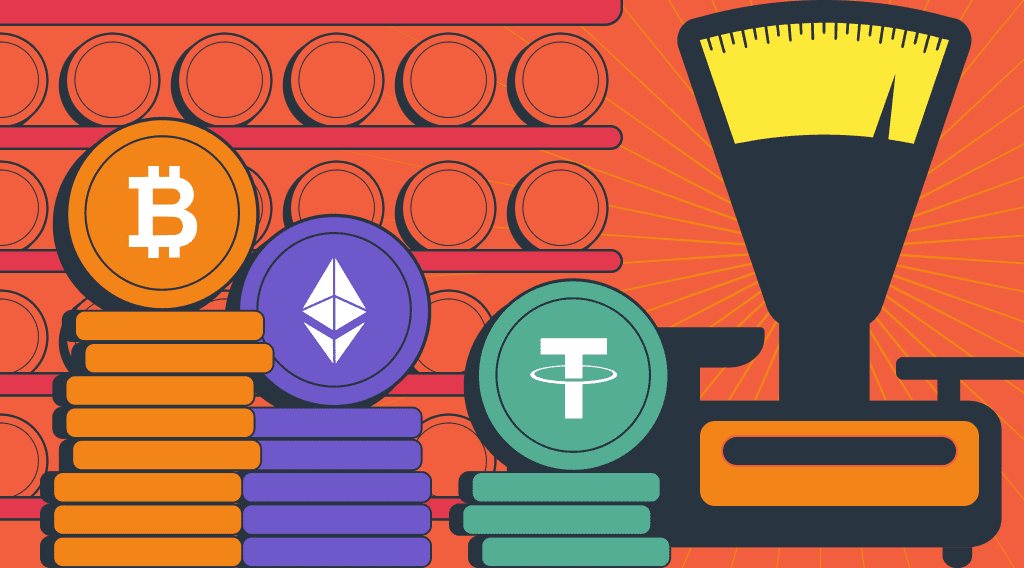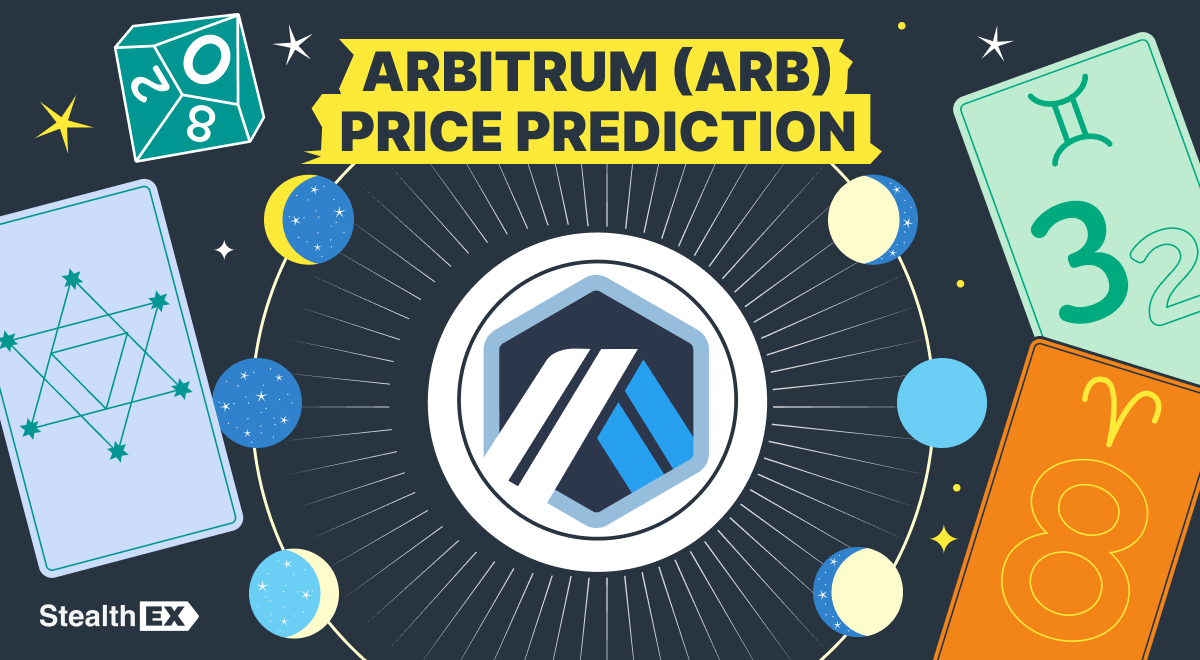Crypto Market Cap: What Is Market Capitalization in Cryptocurrency?

You might have wondered what is crypto market cap and why it matters in the world of cryptocurrency. In this article, we’ll try to understand what crypto market cap is and which factors influence it.
Article contents
What Is Crypto Market Cap?
First of all, market capitalization illustrates the overall size of a cryptocurrency’s place in the market. To calculate a coin’s market cap, you multiply the number of coins that have been issued by the price of a single coin. Market cap can be used to compare and rank coins within the crypto market.
Each crypto asset has different ways of determining its supply. On average, there are 900 new Bitcoins mined daily, until Bitcoin’s total supply reaches 21 million. Therefore, there is daily fluctuation in market cap driven by two forces: supply change and buy or sell pressures.

Thus, market cap shifts and varies along with the prices and circulating supply of crypto coins and tokens. Nonetheless, the main players can be identified easily and rarely change. Here are the top 10 cryptos by market cap in U.S. dollars in the beginning of 2023 (information provided by CoinMarketCap, the number one website for crypto data):
- Bitcoin: $409.8B
- Ethereum: $193.3B
- Tether: $66.4B
- BNB: $47.8B
- USD Coin: $43.9B
- XRP: $19.8B
- Binance USD: $16.1B
- Cardano: $12.2B
- Dogecoin: $11.5B
- Polygon: $8.7B
You can read more about most of these cryptocurrencies in our previous article on crypto by market cap: Top 10 Cryptocurrencies of 2022 by Market Cap. CoinMarketCap calculates all prices by the volume-weighted average of all the prices from different exchanges. It’s also important to monitor the circulating supply of a cryptocurrency. After all, it is only the circulating supply that is really available on the market right now. However, the market cap of a cryptocurrency more or less reflects the popularity of a coin over a longer term.
Fully Diluted Supply and Realized Crypto Market Cap
When crypto enthusiasts refer to the total supply of a cryptocurrency, they sometimes use the term fully diluted supply (FDV). A fully diluted market cap is calculated based on the value of all the coins in a cryptocurrency, not just the ones in circulation. One of the reasons Bitcoin (BTC) continues to do well is that its fully diluted supply is only 21 million. Currently, there are over two million of these coins left to be mined, as the total circulating supply of BTC is more than 18 million. As a result, BTC is one of the best-performing assets, driven by its scarcity and utility.
When discussing a token’s supply, it’s critical to differentiate whether one is using FDV or circulating supply as their standard. Taking market capitalization into account allows one to see the macro picture for more informed investment decisions.
The second alternative market cap metric is ‘realized’ market cap, made popular by metrics sites like Coin Metrics and Messari. Realized market cap recognizes that, just like with ‘fully diluted market cap,’ the total market cap of a coin ignores the full picture. It does not take into account coins that have been lost, forgotten about, owned by the deceased or withheld from their owners. Realized market cap attempts to address this by only taking into account coins that have recently moved from the network. For this reason, the realized market cap is smaller than the actual one. On Coin Metrics, Bitcoin has a total crypto market cap of $823 billion, it has a realized market capitalization of $462 billion.
Cryptocurrency Market Cap: General Information
Cryptos with higher market caps generally have more investors and more influence over the price of other coins and tokens. That’s one reason a cryptocurrency’s market cap is the customary basis for ranking it within the crypto market.
Large-cap cryptocurrencies are generally considered to be safe crypto investments. These are companies with a market cap of more than $10B. Investing in coins with large market capitalization is usually a conservative strategy. These coins are likely to be less volatile than other cryptocurrencies but still more volatile than traditional assets like stocks.
Mid-cap cryptos are more volatile but also have a lot more growth potential than large-cap cryptocurrencies. Small-cap cryptocurrencies are often extremely volatile and considered a highly risky investment, albeit sometimes with a lot of potential (short-term) growth. However, these can often crash, even though there are exceptions, as with the infamous LUNA/UST downfall that happened in May of 2022. Before the crash, it ranked among the top 10 most valuable cryptocurrencies and yet went down pretty fast.
Additionally, cryptocurrency experts notice that if a cryptocurrency has a market cap of $1 billion, it doesn’t mean that $1 billion has flown into that cryptocurrency. In this case, maybe $50 million actually moved into cryptocurrency. So if the coin collapses and its market cap goes from $1B to zero, the investors would lose only $50 million.
Trading Volumes
Alternatively, a token’s trading volume can help determine how popular a coin is. Trading volumes are calculated by determining the worth of all coins traded in a given timeframe, like a day, week, or year. Volumes do not indicate the health of a market; a coin may have high volumes if lots of people want to sell the token at once, like in the event of a market crash. That said, volumes do a decent job at indicating the popularity of that token or coin (not taking into account wash trading, the practice whereby the same party, usually an exchange or a coin creator, buys and sells lots of the same coin to inflate volumes).
Stablecoins like Tether, Binance USD, and USDC often have some of the largest daily volumes because they are used as stable assets when trading in and out of more volatile currencies. Stablecoin volumes usually rise in times of market panic, as investors will use them as hedges against volatility. Bitcoin and Ethereum also have high volumes. These currencies are far from stable, but their huge market capitalizations make them slightly more resilient to market forces.
Cryptocurrency Price Change
This is a change in the price of a currency over a given period of time (e.g. one hour, one day, one week, etc.). It’s usually shown as a percentage. For example, if the price drops from 100 EUR to 50 EUR in the last week, then the change will be displayed as -50%. Most charts will show a change in the last hour and the day, but it is also useful to check other time frames.
Which time frame you focus on will depend primarily on your interests. Experienced traders are usually interested in short-term periods, while experienced investors are usually more interested in long-term periods of time.
How to Use a Crypto Weighted Market Cap Strategy
Many experts claim that a weighted market cap strategy can help investors even if they are only investing in Bitcoin and Ethereum. A weighted market cap strategy means you put a proportional investment into each asset based on market cap.
So if you take the total market capitalizations of both Bitcoin and Ethereum, then divide out the percentages each individual crypto holds in that total, you’d end up with about 71% Bitcoin and 29% Ethereum. This approach can help you determine how to invest $100 in the two biggest cryptocurrencies: You’d invest about $71 in Bitcoin and $29 in Ethereum.
It’s also important to remember that because crypto prices fluctuate so dramatically, market capitalization is constantly changing. This fluctuation – along with the potential for the market to drop out entirely – is also why experts recommend keeping any investment extremely limited, and only to invest what you’re okay with losing.
Is Crypto Market Capitalization an Important Metric?
There’s a lot of debate about how much weight should be placed on the size of the cryptocurrency market. Some crypto enthusiasts believe that crypto market cap are the thing of the past that are valid only for stock markets.
However, crypto market caps can also give us a fact-based look at how altcoins are performing – this can be useful for planning future investments or tracking down popular coins.
From Bitcoin to Polkadot, Tether to ZCash, and EOS to SushiSwap, you can find comprehensive details about market capitalization on CoinMarketCap. This can help you make informed investment decisions about crypto assets in real-time as blockchain technology and digital currencies continue to gain momentum.
If you are looking to buy crypto safely, you can always use the user-friendly and non-custodial StealthEX crypto exchange platform. You can purchase crypto privately and without the need to sign up for the service. Our crypto collection has more than 650 different coins and you can do wallet-to-wallet transfers instantly and problem-free.
Just go to StealthEX and follow these easy steps:
- Choose the pair and the amount you want to exchange. For instance, BTC to ETH.
- Press the “Start exchange” button.
- Provide the recipient address to transfer your crypto to.
- Process the transaction.
- Receive your crypto coins.
Make sure to follow us on Medium, Twitter, Telegram, YouTube, and Publish0x to stay updated about the latest news on StealthEX.io and the rest of the crypto world.
Don’t forget to do your own research before buying any crypto. The views and opinions expressed in this article are solely those of the author.
Bitcoin capitalization CoinMarketCap crypto market cap Market CapRecent Articles on Cryptocurrency
 Crypto News: Trump Media Approved, Cardano's Bitcoin Bridge, XRP's Ethereum Plans
Crypto News: Trump Media Approved, Cardano's Bitcoin Bridge, XRP's Ethereum Plans  Arbitrum Price Prediction: Is ARB Crypto a Good Investment?
Arbitrum Price Prediction: Is ARB Crypto a Good Investment? 
